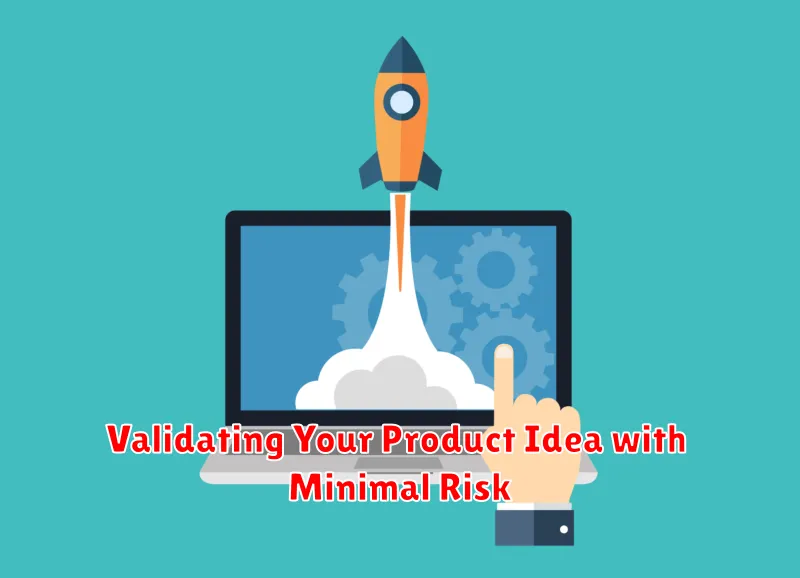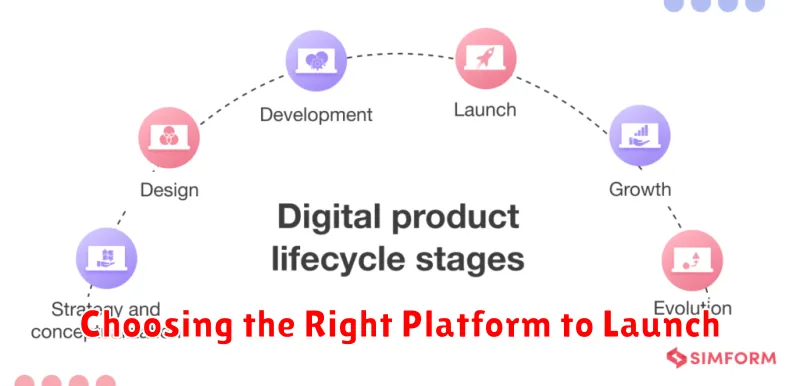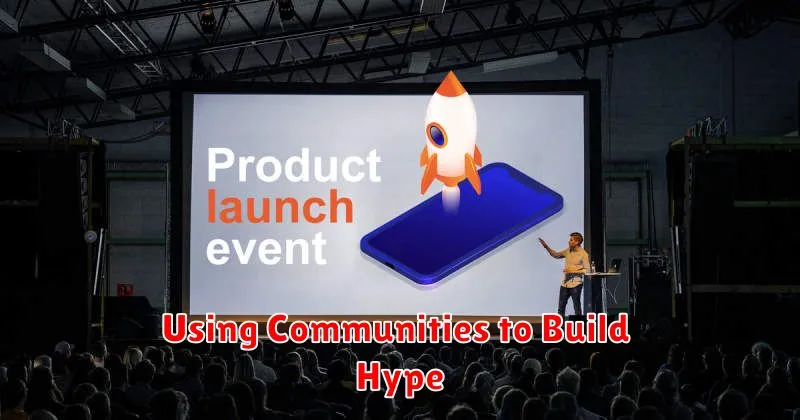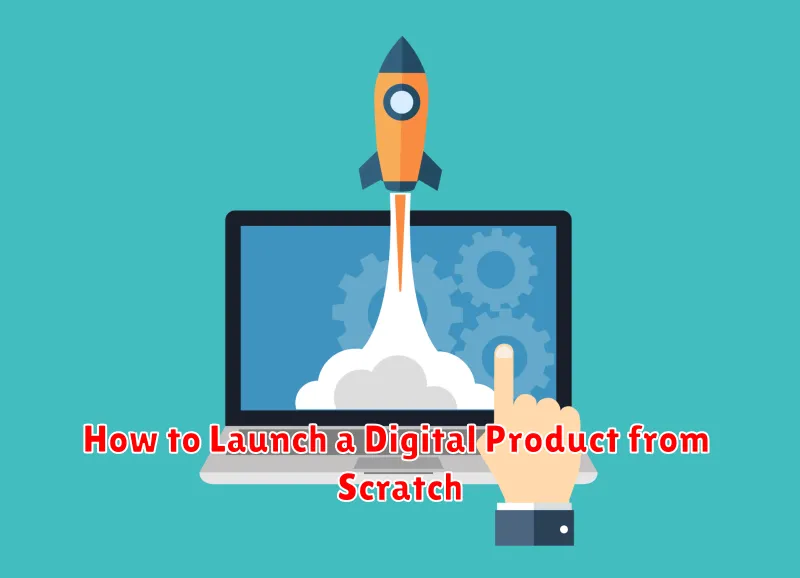Launching a digital product can seem daunting, but with the right approach, it can be a rewarding experience. This comprehensive guide provides a step-by-step process on how to launch a digital product from scratch, covering everything from initial ideation and product development to effective marketing and launch strategies. Whether you’re developing a mobile app, online course, software, or any other type of digital product, understanding the key stages of a successful launch is crucial for maximizing your chances of success. This guide will equip you with the knowledge and practical tips to navigate the complexities of bringing your digital product to market.
This article breaks down the process of launching a digital product from scratch into manageable phases. We’ll explore market research techniques to identify your target audience and validate your product idea. We’ll delve into the specifics of product development, including defining your Minimum Viable Product (MVP) and choosing the right development tools. Furthermore, we’ll cover essential pre-launch activities, such as building an email list and generating pre-orders. Finally, we’ll discuss effective marketing strategies to create buzz and drive sales upon launch. Follow along to learn how to successfully launch your digital product and achieve your business goals.
Why Digital Products Are Great for Passive Income
Digital products offer a compelling avenue for generating passive income. Once created, they can be sold repeatedly without requiring continuous direct involvement from the seller. This scalability is a key advantage, as the potential for income isn’t limited by time or physical resources. Automation plays a crucial role, with platforms handling delivery and payment processing, freeing up the creator to focus on other ventures or simply enjoy the fruits of their labor. This differs significantly from traditional businesses that often require constant upkeep and active participation for sustained revenue.
The low overhead associated with digital products further enhances their attractiveness for passive income generation. Unlike physical products, there are no manufacturing, storage, or shipping costs. This significantly reduces the initial investment and ongoing expenses, maximizing profit margins. Creators retain greater control over pricing and can experiment with different strategies to optimize revenue. Furthermore, the global reach of the internet allows digital products to access a vast market, significantly expanding the potential customer base compared to localized brick-and-mortar businesses.
Several types of digital products lend themselves well to passive income streams. These include:
- Online Courses and Educational Materials: Sharing expertise through video tutorials, ebooks, or interactive learning platforms.
- Software and Applications: Developing tools or utilities that solve specific problems for users.
- Digital Art and Design Templates: Creating graphics, fonts, website themes, or other design assets.
- Stock Photography and Videography: Licensing high-quality visuals for commercial use.
- Music and Audio Tracks: Producing royalty-free music or sound effects.
Validating Your Product Idea with Minimal Risk

Validating your product idea before significant investment is crucial for mitigating risk and maximizing potential success. Early validation confirms market demand and identifies potential issues, allowing you to refine your concept and avoid costly mistakes. Rather than building a full-fledged product, focus on gathering feedback on core functionalities and value propositions through low-risk methods. This approach allows for iterative development and pivoting based on real-world data, ultimately increasing the likelihood of a successful product launch.
Several effective methods exist for validating your product idea without incurring significant expenses. Creating a Minimum Viable Product (MVP) allows you to test core features with a target audience, gathering valuable insights on usability and demand. Surveys and questionnaires can provide quantifiable data on market interest and preferences. Pre-selling or crowdfunding campaigns can gauge market demand and generate early revenue, while simultaneously validating your pricing strategy. Competitor analysis can help identify gaps in the market and refine your unique selling proposition.
By utilizing these methods, you can gather concrete evidence of your product’s potential and make informed decisions about future development. Remember to focus on collecting actionable feedback, identifying specific areas for improvement, and iteratively refining your product based on market response. This process of continuous validation significantly reduces the risk of investing time and resources into a product that ultimately fails to meet market needs.
Creating Value-Driven Content
Value-driven content prioritizes providing genuine benefit to the audience. This goes beyond simple entertainment or promotion, focusing on offering information, insights, or resources that address a need or solve a problem. By focusing on the audience’s needs, value-driven content fosters trust, builds stronger relationships, and ultimately achieves greater impact than content solely focused on marketing or entertainment.
Creating such content requires careful consideration of the target audience. Understanding their demographics, interests, and pain points is crucial. Research is key, involving analyzing data, conducting surveys, and actively listening to feedback. This allows content creators to tailor their message effectively, delivering relevant information in a format the audience finds accessible and engaging. Ultimately, this enhances the perceived value of the content.
Measuring the effectiveness of value-driven content goes beyond simple metrics like views or clicks. It involves assessing engagement, such as shares, comments, and time spent interacting with the content. More importantly, it requires analyzing how the content influences audience behavior. Do users take desired actions, such as signing up for a newsletter or making a purchase? This deeper analysis provides valuable insights for future content development, ensuring continuous improvement and sustained value delivery.
Types of Digital Products You Can Sell
The digital marketplace offers a wide array of opportunities for entrepreneurs and creators. Digital products, unlike physical goods, are intangible assets that can be sold and distributed online. They offer the advantage of low overhead costs and the potential for passive income. Some popular categories include educational resources like online courses and ebooks, creative assets such as stock photos, graphics, and templates, and software tools ranging from mobile apps to website plugins. Choosing the right product depends on your skills, target audience, and market demand.
Educational products can take various forms. Online courses can provide structured learning experiences, while ebooks offer in-depth knowledge on specific topics. Workbooks, templates, and cheat sheets are valuable supplementary materials. If you possess expertise in a particular field, sharing your knowledge through these digital products can be both lucrative and fulfilling. Creative assets cater to designers, marketers, and content creators. Selling stock photos, graphics, templates, fonts, and other design elements can provide a steady income stream. The key is to create high-quality, visually appealing resources that meet market needs.
Finally, software products can range from small utility apps to complex software solutions. These can include mobile apps, desktop software, website plugins, and SaaS (Software as a Service) platforms. Developing software requires technical expertise but can be highly rewarding, especially with recurring subscription models. The success of a software product depends on its functionality, user experience, and marketing strategy. Regardless of your chosen category, thoroughly researching your niche and understanding your target audience are crucial for success in the digital marketplace.
Choosing the Right Platform to Launch

Launching a new product or service requires careful consideration of the platform you choose. The right platform can significantly impact your reach, user engagement, and ultimately, your success. Factors such as your target audience, budget, and the specific features you require will play a key role in determining the best fit. For example, a mobile-first audience might necessitate prioritizing app stores, while a B2B product may benefit from a dedicated web platform.
Evaluate the strengths and weaknesses of each potential platform. Consider factors like user demographics, platform fees, and available marketing tools. If your product relies heavily on visuals, a platform like Instagram or Pinterest might be a strong contender. Conversely, a platform like LinkedIn might be more suitable for a professional service. Don’t overlook the importance of community and support within the platform’s ecosystem. A thriving community can provide valuable feedback and facilitate organic growth.
Finally, test and iterate. Rarely is the first choice the perfect choice. Start with a small-scale launch on your chosen platform, gather data, and analyze the results. Be prepared to adjust your strategy based on user feedback and performance metrics. This iterative approach will allow you to refine your approach and maximize your chances of a successful launch.
Pre-Sales and Waitlist Strategy
A pre-sales and waitlist strategy is a powerful tool for building hype and generating early revenue before a product or service launch. It involves offering customers the opportunity to purchase or reserve their spot in advance, often with exclusive benefits like discounts, early access, or bonus content. This helps to validate market demand, gauge interest, and secure initial sales, mitigating the risk associated with launching a new offering. A successful pre-sales strategy requires clear communication about the product’s value proposition and a compelling offer that incentivizes early adoption.
A waitlist, on the other hand, focuses more on building anticipation and exclusivity when availability is limited or a product is in high demand. It allows businesses to capture leads and nurture them with targeted messaging until the product becomes available. A waitlist is particularly effective for creating a sense of scarcity and FOMO (Fear of Missing Out), which can drive conversions. Key elements of a successful waitlist strategy include a clear explanation of why customers should join, regular updates to keep them engaged, and a smooth onboarding process once the product or service is ready.
Both pre-sales and waitlists can be valuable assets in a launch strategy. Pre-sales focus on securing early sales and generating revenue, while waitlists prioritize building anticipation and capturing leads. Choosing the right approach depends on factors such as product type, target audience, and overall marketing goals. Ultimately, a well-executed pre-sales or waitlist campaign can significantly boost a product launch and contribute to long-term success.
Pricing and Positioning Tactics
Pricing and positioning are crucial elements of a successful marketing strategy. Pricing tactics involve selecting the optimal price point for a product or service to maximize profitability while remaining competitive. These tactics include cost-plus pricing, value-based pricing, competitive pricing, and premium pricing, each with its own advantages and disadvantages depending on the product, target market, and competitive landscape.
Positioning refers to how a product or service is perceived by consumers relative to competing offerings. Effective positioning differentiates a product and creates a unique value proposition in the minds of the target audience. Key positioning strategies include focusing on product attributes, benefits, usage occasions, user groups, or positioning against a competitor.
By carefully aligning pricing and positioning tactics, businesses can create a compelling offer that resonates with their target market and drives sales. For example, a premium-priced product should be positioned to highlight its superior quality, exclusive features, or prestigious brand image to justify the higher cost. Conversely, a value-priced product might emphasize affordability and practicality.
Using Communities to Build Hype

Community engagement is crucial for building hype around a product, service, or event. By cultivating a dedicated and enthusiastic online community, you can create a powerful network of advocates who will organically spread the word and generate excitement. This involves actively participating in relevant online forums, social media groups, and other platforms where your target audience congregates. Providing valuable content, fostering discussions, and responding to inquiries builds trust and cultivates a sense of belonging, which translates into genuine hype and anticipation.
Leveraging influencers within your target community can significantly amplify your message. Influencers, with their established credibility and large following, can effectively communicate your value proposition and generate significant buzz. Collaborating with influencers on content creation, giveaways, and other promotional activities can significantly expand your reach and foster a sense of exclusivity and anticipation among their followers, further fueling the hype.
Hosting exclusive events and offering early access to your product or service for community members can generate a sense of excitement and anticipation. These events can range from online Q&A sessions and behind-the-scenes glimpses to limited beta testing opportunities. This not only rewards loyal community members but also creates a sense of exclusivity and urgency, further driving hype and encouraging wider participation.
Email and Social Launch Checklist
Before launching your email and social media campaigns, it’s crucial to double-check all elements to ensure a smooth and successful rollout. Review your email copy for clarity, accuracy, and compelling calls to action. Test your emails across different devices and email clients to ensure proper formatting and avoid deliverability issues. Confirm your target audience segmentation for precise targeting.
On the social media front, verify all scheduled posts for correct dates, times, and platform-specific formatting. Double-check all links and hashtags for accuracy and relevance. Ensure all visuals are optimized for each platform and aligned with your brand guidelines. Preview your posts to catch any last-minute errors.
Finally, monitor your campaigns closely after launch. Track key metrics like open rates, click-through rates, and engagement to gauge performance. Be prepared to adapt your strategy based on the data you collect. Addressing issues promptly will maximize your campaign’s effectiveness.
Post-Launch Optimization Tips
After launching your product or service, the work doesn’t stop. Post-launch optimization is crucial for long-term success. Focus on gathering user feedback through surveys, analytics, and direct communication. This feedback is invaluable for identifying areas for improvement, whether it’s addressing bugs, refining user interface, or adjusting marketing strategies. Acting on this feedback quickly demonstrates responsiveness and builds user trust.
Continuously monitor key performance indicators (KPIs) such as conversion rates, customer acquisition cost (CAC), and customer lifetime value (CLTV). Analyzing these metrics helps you understand what’s working and what’s not. Based on the data, iterate on your product or service, refine your messaging, and optimize your marketing campaigns to improve overall performance and achieve your business goals. Data-driven decisions are essential for sustainable growth.
Don’t neglect ongoing promotion. Keep your audience engaged with fresh content, special offers, and community building activities. Consider strategies like content marketing, social media engagement, and email marketing to maintain momentum and attract new customers. Consistent engagement keeps your product or service top-of-mind and reinforces its value.

